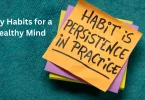In today’s fast-paced, digitally-driven world, stress, anxiety, and emotional exhaustion have reached epidemic levels. The constant barrage of notifications, societal pressures, and personal responsibilities can leave us feeling overwhelmed and disconnected from ourselves. Amid this chaos, one ancient practice has emerged as a scientifically validated solution: mindfulness for emotional health.
This comprehensive guide will take you on a deep dive into mindfulness for emotional health, exploring its psychological benefits, neurological effects, practical techniques, and real-world applications. You’ll discover not just the “how” but also the “why” behind mindfulness, empowering you to make it an integral part of your emotional well-being toolkit.
Understanding Mindfulness for Emotional Health
What Is Mindfulness?

Mindfulness is more than just a buzzword—it’s a way of being. Rooted in Buddhist traditions but now widely secularized, mindfulness involves:
- Present-moment awareness – Fully engaging with the here and now, rather than dwelling on the past or worrying about the future.
- Non-judgmental observation – Not labeling thoughts or emotions as “good” or “bad,” but simply noticing them with curiosity.
- Acceptance – Allowing experiences to unfold without resistance, which paradoxically reduces their intensity.
Unlike some forms of meditation that focus on emptying the mind, mindfulness encourages a gentle awareness of whatever arises—thoughts, emotions, bodily sensations—without getting caught up in them.
The Profound Connection Between Mindfulness and Emotional Health
Emotional health isn’t about being happy all the time—it’s about having the skills to navigate life’s ups and downs with balance and wisdom. Mindfulness for emotional health strengthens this capacity by:
- Breaking the autopilot cycle – Most emotional reactions are habitual. Mindfulness creates space between stimulus and response, allowing for conscious choice.
- Enhancing emotional granularity – Helping you recognize subtle differences between emotions (e.g., irritation vs. anger vs. frustration) for better regulation.
- Reducing emotional avoidance – Many psychological issues stem from suppressing emotions. Mindfulness teaches us to approach difficult feelings with openness.
- Rewiring the brain’s stress response – Regular practice decreases activity in the amygdala (fear center) while strengthening prefrontal regulation.
The Science Behind Mindfulness for Emotional Well-Being
How Mindfulness Physically Changes Your Brain
Groundbreaking neuroscientific research reveals that mindfulness induces structural and functional changes in the brain:
- Increased gray matter density – Studies show growth in the prefrontal cortex (decision-making), hippocampus (memory/emotion regulation), and insula (body awareness).
- Decreased amygdala volume – The brain’s threat detector shrinks, leading to less reactivity to stressors.
- Enhanced connectivity – Improves communication between emotional and regulatory brain regions, creating better emotional balance.
These changes explain why long-term practitioners experience:
✔ Fewer intense emotional swings
✔ Quicker recovery from upsetting events
✔ Greater ability to focus despite distractions
Psychological Benefits Beyond Stress Reduction
While stress relief is mindfulness’ most touted benefit, its psychological impacts run much deeper:
- Breaking rumination cycles – Mindfulness disrupts the repetitive negative thinking that fuels depression.
- Reducing emotional reactivity – Creates a “pause button” between feeling and action, preventing regrettable outbursts.
- Enhancing self-compassion – Shifts harsh self-criticism to kind awareness, particularly beneficial for those with shame or trauma histories.
- Improving relationship satisfaction – By being fully present with others, conflicts decrease while intimacy grows.
Practical Mindfulness Techniques for Emotional Health
1. Mindful Breathing: Your Emotional Anchor
This fundamental practice serves as an always-available emotional reset:
- The 4-7-8 technique: Inhale for 4 counts, hold for 7, exhale for 8 to rapidly calm the nervous system.
- Noticing the pause – Pay special attention to the brief stillness between breaths, which cultivates mental clarity.
- Counting breaths – When distracted, silently count “1” on the inhale, “2” on the exhale up to 10, then repeat.
Pro tip: Practice for just 90 seconds when stressed—long enough to shift physiological arousal.
2. Body Scan Meditation: Releasing Emotional Residue
Emotions manifest physically (tight shoulders with stress, stomach knots with anxiety). The body scan:
- Reveals emotional holding patterns – You might discover tension you didn’t realize you carried.
- Prevents emotional bypassing – By connecting to bodily sensations, you process emotions more completely.
- Try the “wave of relaxation” method: Imagine each exhale as a wave melting tension from head to toe.
3. Observing Emotions Like Weather Patterns
Advanced emotional regulation involves:
- Naming to tame – Silently labeling emotions (“anger is here”) reduces their intensity by engaging the prefrontal cortex.
- Locating emotions in the body – Anxiety might feel like chest tightness, sadness like heaviness in the limbs.
- The RAIN technique:
- Recognize the emotion
- Allow it to be present
- Investigate bodily sensations
- Nurture yourself with compassion
4. Loving-Kindness Meditation: Healing Emotional Wounds
Particularly powerful for those struggling with self-criticism or interpersonal conflicts:
- Phases of expansion: Start with yourself, then move to loved ones, neutral people, difficult people, and all beings.
- Customized phrases: Tailor mantras to your needs (e.g., “May I feel safe” for anxiety, “May I forgive myself” for guilt).
- Neuroscience bonus: Activates brain regions linked to positive emotions and social connection.
5. Mindful Journaling: Emotional Archaeology
Structured prompts enhance emotional insight:
- “What am I resisting right now?” – Reveals hidden emotional struggles.
- “Where did I feel this in my body?” – Strengthens mind-body awareness.
- “What’s the story I’m telling?” – Identifies cognitive distortions amplifying emotions.
Mindfulness for Specific Emotional Challenges
Managing Anxiety: From Panic to Presence
Anxiety thrives on “what if” future thinking. Mindfulness counters this by:
- Grounding techniques: The 5-4-3-2-1 method (name 5 things you see, 4 you feel, etc.) for panic attacks.
- Unhooking from thoughts: Visualizing anxious thoughts as leaves floating down a stream creates detachment.
- Embracing uncertainty: Practicing “don’t know mind” reduces the need for absolute certainty that fuels anxiety.
Overcoming Depression: Lighting Up the Darkness
Depression’s hallmark is rumination—the endless recycling of negative thoughts. Mindfulness helps by:
- Spotting the early warning signs – Noticing subtle shifts in mood before they intensify.
- Engaging in valued actions – Using mindfulness to take small steps even when motivation is low.
- The “and yet” practice: Acknowledging difficulties (“I feel hopeless… and yet I’m brushing my teeth”) builds momentum.
Transforming Anger: From Volcano to Volcano Watcher
Mindfulness turns destructive anger into wise action:
- The anger timer: Setting a 90-second timer to fully feel the physical experience of anger (which typically peaks and passes in this time).
- Finding the primary emotion – Anger often masks hurt, fear, or shame. Mindfulness reveals these deeper layers.
- The STOP method:
- Stop
- Take a breath
- Observe bodily sensations
- Proceed with intention
Think this is interesting? The next section will blow your mind.
“Feel Better Fast: Improve Your Mood Naturally Today”
Boost Happiness Now: Mind and Mood Wellness Tips That Work!
“Transform Your Life: Balanced Diet and Healthy Living
Healthy Living for Beginners: Discover the Joy of Wellness
Building Emotional Resilience: The Anti-Fragile Mind
Resilience isn’t about toughness—it’s about adaptability. Mindfulness cultivates this by:
- The “guest house” metaphor: Viewing difficult emotions as temporary visitors reduces their threat.
- Post-traumatic growth practices: Using mindfulness to find meaning after hardship.
- Micro-moments of positivity: Noticing and savoring small joys rewires the brain’s negativity bias.
Integrating Mindfulness into Daily Life
Mindful Eating: The 80% Full Revolution
Transform your relationship with food by:
- The raisin exercise: Slowly exploring one raisin with all senses before eating resets eating habits.
- Hunger-fullness scale: Checking in at “am I at a 3 (hungry) or a 7 (full)?” prevents emotional eating.
- Gratitude bites: Pausing to appreciate the journey of your food from earth to plate enhances satisfaction.
Mindful Communication: The Art of Deep Listening
Revolutionize your relationships through:
- The WAIT technique – Asking “Why Am I Talking?” before speaking improves communication quality.
- Noticing listening barriers – Spotting when you’re formulating responses instead of truly hearing.
- Mindful pauses – Taking three breaths before responding in difficult conversations.
Mindful Movement: Yoga, Walking, Tai Chi
Combine physical and emotional benefits:
- Walking meditation – Noticing the lift, move, place of each footstep anchors you in the present.
- Yoga for emotional release – Certain poses (like hip openers) release stored emotional tension.
- Dynamic mindfulness – Bringing full awareness to chores like washing dishes or folding laundry.
Common Misconceptions About Mindfulness

“Mindfulness Means Emptying the Mind”
Reality: The goal isn’t thought suppression—it’s changing your relationship to thoughts. Even experienced practitioners have mental chatter; they just don’t get entangled in it.
“It’s Only for Spiritual People”
Reality: While rooted in contemplative traditions, modern mindfulness is evidence-based. Hospitals, corporations, and militaries worldwide use secular mindfulness programs.
“You Need Hours of Practice to Benefit”
Reality: Research shows even brief, consistent practice (10 mins/day) yields measurable changes. The key is regularity over duration.
“Mindfulness Is Passive Acceptance”
Reality: Mindfulness includes wise action—first clearly seeing reality, then responding skillfully rather than reacting impulsively.
The Future of Mindfulness in Emotional Health
As mental health paradigms shift from pathology to prevention, mindfulness for emotional health is becoming integral to:
- Digital therapeutics – App-based mindfulness programs with personalized emotional tracking.
- Trauma-sensitive adaptations – Modified practices for PTSD that avoid re-traumatization.
- Organizational emotional intelligence – Companies training employees in mindfulness to reduce burnout and improve leadership.
- Youth emotional education – School programs teaching mindfulness to build emotional resilience early.
Emerging research explores mindfulness’ role in:
🔹 Epigenetics – How practice affects stress-related gene expression
🔹 Neuroplasticity – The speed at which brain changes occur
🔹 Psychedelic integration – Using mindfulness to process and retain insights from therapeutic psychedelics
Conclusion: Your Journey With Mindfulness for Emotional Health
Embarking on the path of mindfulness for emotional health is like training for emotional fitness—it requires patience, consistency, and self-compassion. Unlike medications that mask symptoms or talk therapy that analyzes the past, mindfulness offers a direct way to transform your present-moment experience.
Remember:
- Progress isn’t linear – Some days will feel easier than others. This is normal.
- Small steps create big changes – Even one mindful breath daily builds the neural circuitry for emotional balance.
- Community matters – Joining a mindfulness group or finding an accountability partner deepens practice.
Conclusion:
As you continue exploring mindfulness for emotional health, notice the subtle shifts—perhaps responding instead of reacting to a provocation, or catching negative thought patterns earlier. These small victories accumulate into profound transformation.Your emotional well-being is worth this investment. Why not pause right now and take three mindful breaths? The journey of a thousand miles begins with this single, present-moment step.
FAQs
Can mindfulness really help with anxiety and depression?
Absolutely. Mindfulness trains your brain to observe anxious or depressive thoughts without getting tangled in them. Instead of spiraling into worry or sadness, you learn to recognize these patterns early and respond with calm awareness.
How long does it take to see benefits from mindfulness practice?
Some people notice small changes—like feeling slightly calmer or more focused—after just a few sessions. However, lasting emotional shifts usually take about 8 weeks of consistent practice (10-20 minutes daily).
I can’t stop my thoughts during mindfulness—am I doing it wrong?
Not at all! The goal isn’t to empty your mind but to notice when thoughts arise and gently return to your anchor (like breath or body sensations).
Can mindfulness replace therapy or medication?
While mindfulness is powerful, it’s not always a standalone solution. For clinical anxiety, depression, or trauma, it works best alongside professional treatment.
How is mindfulness different from regular meditation?
Mindfulness is a type of meditation focused on present-moment awareness. Other meditations might involve mantras, visualization, or concentration.






